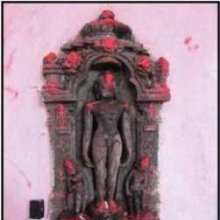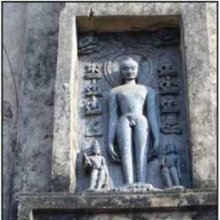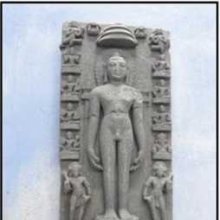Shantinatha, Śāntinātha, Shanti-natha: 6 definitions
Introduction:
Shantinatha means something in Jainism, Prakrit, Hinduism, Sanskrit. If you want to know the exact meaning, history, etymology or English translation of this term then check out the descriptions on this page. Add your comment or reference to a book if you want to contribute to this summary article.
The Sanskrit term Śāntinātha can be transliterated into English as Santinatha or Shantinatha, using the IAST transliteration scheme (?).
Images (photo gallery)
(+20 more images available)
In Jainism
General definition (in Jainism)
Source: Wisdom Library: JainismŚāntinātha (शान्तिनाथ) is another name for Śānti, the sixteenth Tīrthaṅkara (Janism recognizes 24 such teachers or Siddhas). His colour is gold (kāñcana), according to Aparājitapṛcchā (221.5-7). His height is 40 dhanuṣa (a single dhanuṣa (or, ‘bow’) equals 6 ft), thus, roughly corresponding to 73 meters. His emblem, or symbol, is an Antelope or deer.
Śāntinātha’s father is Viśvasena and his mother is Acirā according to Śvetāmbara or Airā according to Digambara. It is an ancient Jain practice to worship the Tīrthaṅkara’s parents in various rites, such as the pratiṣṭhāvidhi, according to the Ācāradinakara (14th century work on Jain conduct written by Vardhamāna Sūri).
Source: archive.org: The Jaina IconographyŚāntinātha (शान्तिनाथ) refers to the sixteenth of twenty-four Tīrthaṃkaras or Jinas, commonly depicted in Jaina iconography.—The cognizance which separates the image of Śāntinātha from those of other Tīrthaṃkaras is a deer. The Yakṣa and Yakṣiṇī attendants escorting him are respectively named as Kiṃpuruṣa and Mahāmānasī (Śvetāmbara: Garuḍa and Nirvāṇī). Rājā Puruṣadatta stands for his Chowri-bearer. The tree under which he attained the Kevala knowledge is Nandi Vṛkṣa.
Regarding the Jina’s parentage, we gather from Jaina books that King Viśvasena was his father and Acirā was his mother. He was born at Hastināpura. In Jaina history of pontiffs, Śāntinātha occupies a very high place. Not only did he revive Jainism, which was in danger of falling into oblivion, but he so consolidated the faith that it never disappeared again. Another extraordinary fact about himis that he was the first Tīrthaṃkara to become a Cakravartī or emperor of the whole of India. The occasion, which gave origin to his name, is that before Śāntinātha’s birth, his mother was able to stay the course of the pestilence which was raging in the kingdom by sprinkling the sufferers with Śānti water. Hence,the name “Śāntinātha” or “Lord of Peace”.
Source: archive.org: TrisastisalakapurusacaritraŚāntinātha (शान्तिनाथ) or Śānti refers to the sixteenth of the twenty-four Tīrthaṅkaras praised in the first book (ādīśvara-caritra) [chapter 1] of Hemacandra’s 11th century Triṣaṣṭiśalākāpuruṣacaritra: an ancient Sanskrit epic poem narrating the history and legends of sixty-three illustrious persons in Jainism.
Accordingly, “[...] we worship the Arhats, who at all times and all places purify the people of the three worlds by their name, representation, substance, and actual existence. [...] May the Jina Śāntinātha, who has brightened the quarters of the sky by the moonlight of his nectar-like words, be a moon to you for dispelling (mental) darkness”.
Source: academia.edu: Tessitori Collection I1) Śāntinātha (शान्तिनाथ) refers to the Sixteenth Jina, according to the Śāntināthacopaī by Jñānasāgara (dealing with Jain universal history such as the Jinas and related figures), which is included in the collection of manuscripts at the ‘Vincenzo Joppi’ library, collected by Luigi Pio Tessitori during his visit to Rajasthan between 1914 and 1919.—The Śāntināthacopaī is structured around the story of the twelve births of the sixteenth Jina, Śāntinātha. [...]
The twelve births of Śāntinātha are:
- as king Śrīsena,
- as twin,
- as god,
- as Amitatejas,
- as god.
- as Aparājita,
- as God,
- as Vajrāyudha,
- as God,
- as Megharatha (see vernacular version in cat. no. 186),
- as God,
- as Śānti.
2) Śāntinātha (शान्तिनाथ) or Śāntināthagīta refers to one of the twenty-four songs (gīta) embedded in the Caturviṃśatijinagīta by Jinarāja (dealing with classical hymns and stotras from Jain literature).

Jainism is an Indian religion of Dharma whose doctrine revolves around harmlessness (ahimsa) towards every living being. The two major branches (Digambara and Svetambara) of Jainism stimulate self-control (or, shramana, ‘self-reliance’) and spiritual development through a path of peace for the soul to progess to the ultimate goal.
Languages of India and abroad
Sanskrit dictionary
Source: Cologne Digital Sanskrit Dictionaries: Monier-Williams Sanskrit-English DictionaryŚāntinātha (शान्तिनाथ):—[=śānti-nātha] [from śānti > śānta] m. Name of an Arhat (with Jainas; = śānti), [Śatruṃjaya-māhātmya]
[Sanskrit to German]
Sanskrit, also spelled संस्कृतम् (saṃskṛtam), is an ancient language of India commonly seen as the grandmother of the Indo-European language family (even English!). Closely allied with Prakrit and Pali, Sanskrit is more exhaustive in both grammar and terms and has the most extensive collection of literature in the world, greatly surpassing its sister-languages Greek and Latin.
See also (Relevant definitions)
Partial matches: Natha, Shanti.
Starts with: Shantinathacaritra, Shantinathacopai, Shantinathagita, Shantinathapurana, Shantinathastavana.
Full-text (+291): Acira, Shantinathapurana, Shantinathacaritra, Vishvasena, Garuda, Nirvani, Ratnadvipa, Cakrayudha, Dhanada, Shatabali, Sudhana, Dhaneshvara, Shripura, Ratinandana, Vasantadeva, Kamapala, Kesara, Jayana, Bindusena, Indusena.
Relevant text
Search found 8 books and stories containing Shantinatha, Śānti-nātha, Santi-natha, Śāntinātha, Santinatha, Shanti-natha; (plurals include: Shantinathas, nāthas, nathas, Śāntināthas, Santinathas). You can also click to the full overview containing English textual excerpts. Below are direct links for the most relevant articles:
Jainism in Odisha (Orissa) (by Ashis Ranjan Sahoo)
Santinatha image at Akhandalesvara Temple, Jajpur Town < [Chapter 3: Survey of Jaina Antiquities in Odisha]
Jaina Antiquities in Manikchauk (Balasore) < [Chapter 3: Survey of Jaina Antiquities in Odisha]
Santinatha at Ganesa Temple, Dasasvamedha Ghata < [Chapter 3: Survey of Jaina Antiquities in Odisha]
Trishashti Shalaka Purusha Caritra (by Helen M. Johnson)
Part 6: Stuti by Daśānana for Śrī Śānti (Śāntinātha) < [Chapter VII - The killing of Rāvaṇa]
Part 7: Founding of Śānti’s congregation < [Chapter V - Twelfth incarnation as Śānti]
Introduction to volume 3 < [Introductions]
Jain Remains of Ancient Bengal (by Shubha Majumder)
Caubisi type of Śāntinātha Sculpture < [Chapter 6 - Iconographic Study of Jaina Sculptural Remains]
Images of Tīrthaṅkara Śāntinātha (Introduction) < [Chapter 6 - Iconographic Study of Jaina Sculptural Remains]
Pañca-tirthika type of Śāntinātha Sculptures < [Chapter 6 - Iconographic Study of Jaina Sculptural Remains]
Bhagavati-sutra (Viyaha-pannatti) (by K. C. Lalwani)
Part 3 - On patriarchs < [Chapter 5]
A study of the philosophy of Jainism (by Deepa Baruah)
Chapter I.c - The lives of the Tīrthaṅkaras < [Chapter I - Introduction]
Tattvartha Sutra (with commentary) (by Vijay K. Jain)





